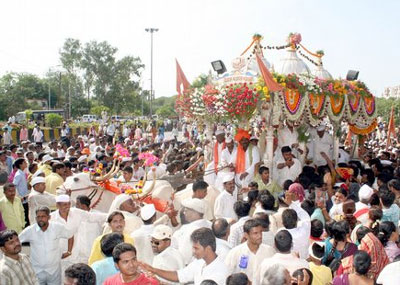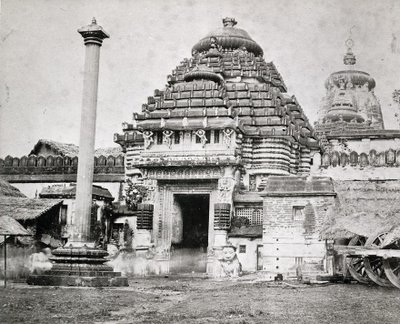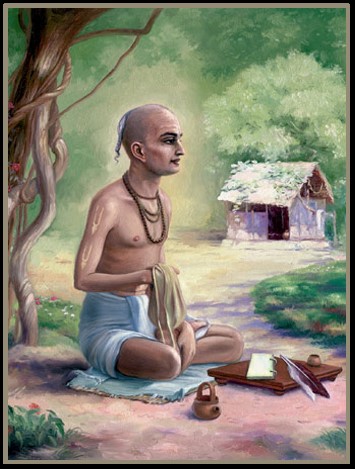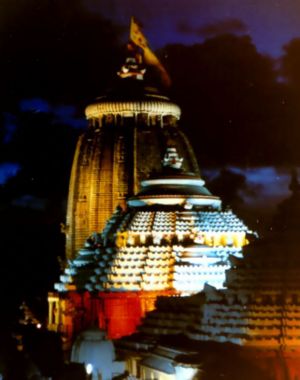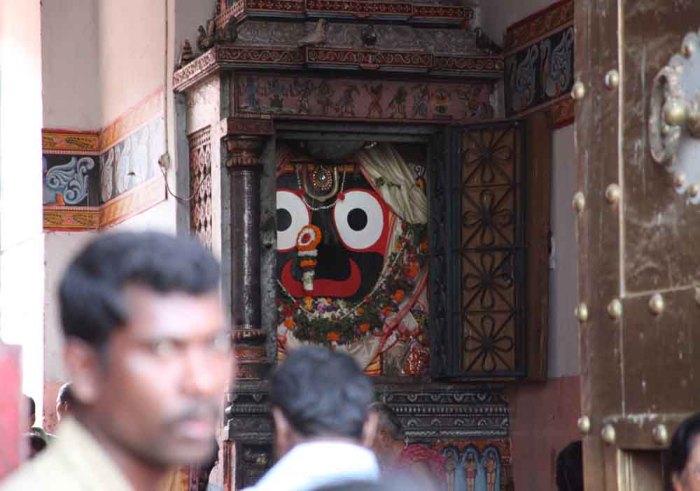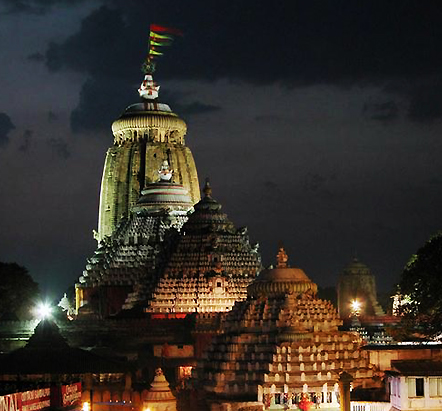The most outstanding display of the Maharashtrians’ devotion to Lord Vitthala is the Dindi Yatra, a pilgrimage on foot that culminates in Pandharpur. It has been performed annually for the last seven hundred years.
 In fact, every month at Pandharpur on Sukla Ekadasi (the eleventh day of the waxing moon), a festival is held that attracts a large number of pilgrims. But, four of these festivals are especially large. And the main one, Dindi Yatra the huge Asadhi Ekadasi festival draws a crowd of 700,000 people. As many as 200,000 come on foot. The festival falls during the month of Asadha (July) and marks the beginning of Caturmasya, the four months of the rainy season. According to the Padma Purana, on that day the Lord goes to sleep for four months. When He wakes up, at the end of the month of Karttika, another festival is held, the second biggest.
In fact, every month at Pandharpur on Sukla Ekadasi (the eleventh day of the waxing moon), a festival is held that attracts a large number of pilgrims. But, four of these festivals are especially large. And the main one, Dindi Yatra the huge Asadhi Ekadasi festival draws a crowd of 700,000 people. As many as 200,000 come on foot. The festival falls during the month of Asadha (July) and marks the beginning of Caturmasya, the four months of the rainy season. According to the Padma Purana, on that day the Lord goes to sleep for four months. When He wakes up, at the end of the month of Karttika, another festival is held, the second biggest.
For each of these festivals, pilgrims come from all the districts of Maharashtra and from other provinces of India like Gujarat, Karnataka, and Andhra Pradesh. The pilgrims follow in the footsteps of their many saints and spiritual leaders. Many of the pilgrims are varkaris.
The word varkari combines the words vari and kari, the former standing for the regular trip to Pandharpur, the latter meaning the one who does it. Varkari thus means “one who journeys to Pandharpur at a specific time in the year.” Varkaris vow to visit Pandharpur every month, or at least once a year, during an Ekadasi festival.
The varkaris form well-organized and disciplined processions called Dindis, which start off from the birthsites and samadhi places of various saints and converge in Pandharpur. The pilgrims travel 150 to 300 kilometers, depending on where they start. The biggest of all Dindis is that of Jnanesvara, which forms a gigantic procession. It originates in Alandi, near Pune, and covers about 250 kilometers in an eighteen-day walk. Some of the smaller groups are on the road for about a month. Many more come by bus and train.
The men on the procession, dressed alike in white dhotis, kurtas, and typical Gandhi hats, walk in lines of six or seven abreast. They beat small brass cymbals, called tal, in such a perfect rhythm that even when several hundred play, it sounds like one person alone. In the front, several men carry saffron flags. Next, a group of men on each Dindi carry a decorated palanquin (palaki) bearing symbolic footprints (padukas) of the saint they follow. The leader of the group walks at the back, playing the vina, accompanied by one or more drum players.
Behind the men follow the women, dressed in bright colorful saris. Some carry tulasi plants in decorated pots on their heads. Others carry pots with water to serve their fellow varkaris.
Fifty to five hundred people walk in each Dindi group. Responding heartily to their kirtana leaders, they sing the mantras jaya jaya vithobha rukhumai! jaya jaya vithobha rukumai! and jaya jaya rama krsna hari, interspersed with lively songs glorifying Lord Vitthala.
Day after day, undaunted by heat or rain, the pilgrims fill the air with tumultous chanting. Sometimes they dance and sometimes run, rushing ecstatically towards Pandharpur and their Lord. In the midst of this procession the words spoken by the Lord in the Padma Purana come alive:
tatra tisthami narada
yatra gayanti mad-bhaktah
“O Narada, I stay where My devotees glorify Me.”
Each Dindi is supported by vehicles trucks and bullock carts carrying crews ahead to cook and set up tents. When the pilgrims stop to rest and have their meals, each group finds its supporting crew just as calves recognize their mothers in the midst of a herd.
No one goes hungry on Dindi. The bigger groups cook in gigantic pots and distribute prasadam to anyone who sits in the line. The government supplies water for drinking and bathing.
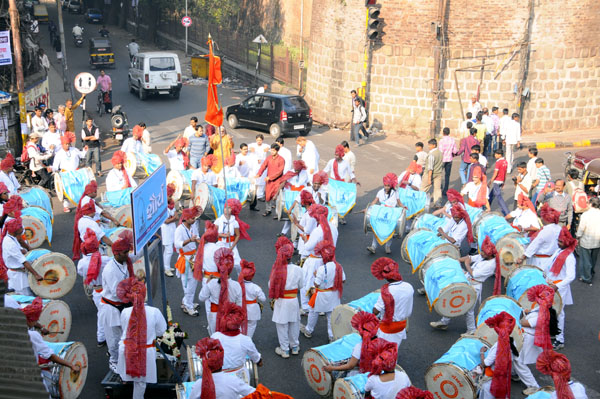 The walkers reach their day’s destination by late afternoon. The convergence of pilgrims, and the symbolic presence of their saints, awakens the sleepy villages with intense religious fervor. In the evening, groups everywhere perform kirtana, and crowds of thousands listen to various speakers, who spice their discourses with songs of the saints, to the tune of musical instruments. These speakers are like one-act players. They entertain and involve their audience, inspiring them to sing along.
The walkers reach their day’s destination by late afternoon. The convergence of pilgrims, and the symbolic presence of their saints, awakens the sleepy villages with intense religious fervor. In the evening, groups everywhere perform kirtana, and crowds of thousands listen to various speakers, who spice their discourses with songs of the saints, to the tune of musical instruments. These speakers are like one-act players. They entertain and involve their audience, inspiring them to sing along.
On Dindi everything is done collectively. Crowds are cooking, crowds sitting in lines for prasadam, crowds sleeping side by side, crowds moving around, crowds queuing up for darsana in the temples along the way, crowds meeting the calls of nature in the fields.… You’re never alone on Dindi.
The dense crowd stretches many kilometers, people walking ahead or struggling in the back to keep up. Many people independently follow the Dindi, carrying their few belongings upon their heads. Some begin walking as soon as they get up, as early as 2 A.M. The main group starts at 6:30.
Walking about fifteen kilometers a day, the Dindis finally reach the outskirts of Pandharpur and unite at Wakhari, a small village three kilometers away. On the eve of the Asadha Ekadasi, still more people join for the last leg of the pilgrimage. The three-kilometer stretch from Wakhari to the holy town of Pandharpur turns into a river of humanity flowing towards the ocean of mercy at the Lord’s lotus feet. In his writings, Bilvamangala Thakura warns travellers passing through Pandharpur, “Do not walk on the bank of the river Bhima. A bluish-black person stands there, and even though His hands rest peacefully on His hips, He is expert at stealing the heart of anyone who sees Him.”
It seems that the varkaris carefully ignore Bilvamangala Thakura’s advice. In fact, they are especially eager to meet that person.
Upon reaching Pandharpur, the pilgrims take a dip in the Candrabhaga River. Then, carrying the palanquins on their shoulders, they perform nagara-pradaksina, walking a circle around the holy town. The circle complete, they queue up all night at the temple to catch a glimpse of Lord Vitthala on the Ekadasi day. In the heavy rush, each will get to see the Lord for perhaps a few seconds. For them it will be enough: their souls will be satisfied, and it will be worth the trouble.
